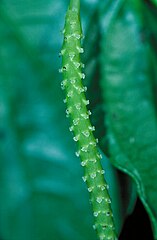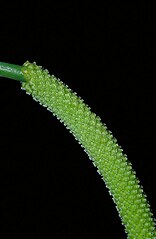Biology:Piper interruptum
| Piper interruptum | |
|---|---|

| |
Script error: No such module "Conservation status".
| |
| Scientific classification | |
| Kingdom: | Plantae |
| Clade: | Tracheophytes |
| Clade: | Angiosperms |
| Clade: | Magnoliids |
| Order: | Piperales |
| Family: | Piperaceae |
| Genus: | Piper |
| Species: | P. interruptum
|
| Binomial name | |
| Piper interruptum | |
| Synonyms[2] | |
Piper interruptum is a vine in the pepper family Piperaceae, native to the eastern parts of Southeast Asia and to Melanesia and Queensland.
Description
Piper interruptum is a root climber with a maximum stem diameter of 2 cm (0.79 in).[3] The leaves are ovate to narrowly ovate and mostly glabrous.[4] They measure up to 16 cm (6.3 in) long by 8.5 cm (3.3 in) wide, with a cuneate base which is often asymmetric, and an acuminate tip.[3][4] There are 1 to 3 pairs of lateral veins, all of which divert from the midvein in the basal portion of the leaf.[4] Petioles are 1 to 2 cm (0.39 to 0.79 in) long and stipules are 0.7 to 0.9 cm (0.28 to 0.35 in) long.[5]
This species is dioecious, meaning that pistillate (functionally female) and staminate (functionally male) flowers are borne on separate plants. The inflorescences are leaf-opposed, pendulous spikes, around 0.4 cm (0.16 in) wide on a peduncle 1 to 2 cm (0.39 to 0.79 in) long. The flowers are minute, just 0.5 mm (0.020 in) wide, and they lack both sepals and petals. Male spikes are 5 to 12 cm (2.0 to 4.7 in) long with the flowers densely clustered along its length, while female spikes are 7 to 19 cm (2.8 to 7.5 in) long and the flowers are arranged in two helical lines.[3][4][5]
The black fruit are, in botanical terms, berries around 4 mm (0.16 in) long and 5 mm (0.20 in) wide. They contain a single brown seed.[3][4][5]
Phenology
In Australia, flowering occurs from January to February,[5] and fruits ripen from June to August.[4][5]
Phytochemistry
The compounds crotepoxide, eupomatene and pipercallosine have been extracted from the stems of this plant.[6]
Taxonomy
This species was first described by the Czech-German botanist Philipp Maximilian Opiz in 1828, his description was published in volume 1 of Carl Borivoj Presl's book Reliquiae Haenkeanae, seu, Descriptiones et icones plantarum.[7]:157
Etymology
The species epithet is from the Latin interruptus, meaning "broken apart" or "interrupted".[5] Opiz wrote in his description spadicibus cylindricus laxis, interruptis − "spadix cylindrical, lax, interrupted" − but it is unclear what he meant by the term.
Distribution and habitat
The distribution of this species is from Taiwan south to the Philippines , New Guinea, the Bismarck Archipelago, the Solomon Islands, Vanuatu and Queensland.[2] In Queensland it occurs on the northeast coast from Cape Tribulation south to Mackay in rainforest, monsoon forest and closed beach/coastal forest, often on soils derived from basalt. The altitude range is from sea level to about 800 m (2,600 ft).[3][4][5][8]
Conservation
This species is listed by the Queensland Department of Environment and Science as least concern.[9] (As of January 2024), it has not been assessed by the IUCN.
Uses
In parts of Asia this species has been used as an anti-flatulent, an emollient to relieve coughing and an antiseptic.[6]
Gallery
References
- ↑ "Piper interruptum". Centre for Plant Biodiversity Research, Australian Government. https://id.biodiversity.org.au/name/apni/116880.
- ↑ 2.0 2.1 2.2 "Piper interruptum Opiz". Royal Botanic Gardens, Kew. https://powo.science.kew.org/taxon/urn:lsid:ipni.org:names:681773-1.
- ↑ 3.0 3.1 3.2 3.3 3.4 "Piper interruptum". Centre for Australian National Biodiversity Research (CANBR), Australian Government. 2020. https://apps.lucidcentral.org/rainforest/text/entities/Piper_interruptum.htm.
- ↑ 4.0 4.1 4.2 4.3 4.4 4.5 4.6 Spokes, T.M. (2021). "Piper interruptum". Australian Biological Resources Study, Department of Climate Change, the Environment and Water: Canberra. https://profiles.ala.org.au/opus/foa/profile/Piper%20interruptum.
- ↑ 5.0 5.1 5.2 5.3 5.4 5.5 5.6 Cooper, Wendy; Cooper, William T. (June 2004). Fruits of the Australian Tropical Rainforest. Clifton Hill, Victoria, Australia: Nokomis Editions. p. 398. ISBN 9780958174213. https://www.nokomis.com.au/product/nokomis-published-books/fruits-australian-tropical-rainforest/.
- ↑ 6.0 6.1 Thebpatiphat, S.; Pengprechaa, S.; Ternaib, B. (1988). "Some constituents of the stems of Piper interruptum Opiz". Journal of the Science Society of Thailand 14: 225–231. doi:10.2306/scienceasia1513-1874.1988.14.225.
- ↑ Presl, Carl Borivoj (1828). Reliquiae Haenkeanae, seu, Descriptiones et icones plantarum. Prague: J.G. Calve. https://www.biodiversitylibrary.org/page/390626. Retrieved 10 March 2023.
- ↑ "Search: species: Piper interruptum | Occurrence records | The Australasian Virtual Herbarium". Australian Government. https://avh.ala.org.au/occurrences/search?taxa=Piper%20interruptum#tab_mapView.
- ↑ "Species profile—Piper interruptum". Queensland Government. 2022. https://apps.des.qld.gov.au/species-search/details/?id=16447.
External links
- View a map of historical sightings of this species at the Australasian Virtual Herbarium
- View observations of this species on iNaturalist
- View images of this species on Flickriver
Wikidata ☰ Q15228203 entry
 |






